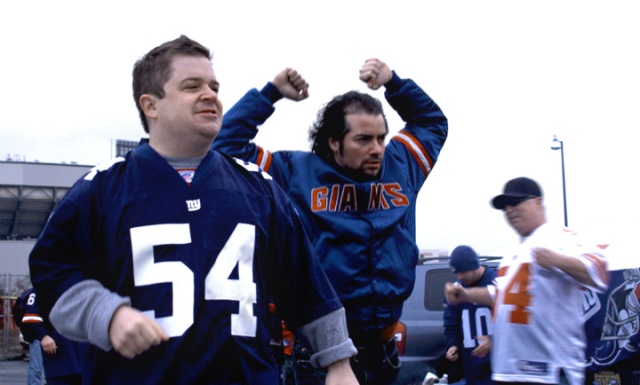Big Fan - parking while Malbin is down

We live in a Golden Age of sports revisionism movies. 2008 brought Anna Boden and Ryan Fleck's Sugar, a tender hymn to washouts, and Darren Aronofsky's The Wrestler, the athlete as sex worker, a body for sale. 2009 brought Wrestler writer Robert Siegel's Big Fan (which the former Onion writer--who claims responsibility for the 'Area Man' trope--wrote and directed), which finds the serious fan on a perpetual seesaw of striving and emasculation. Some spoilers after the jump.
Patton Oswalt plays sad sack and big fan Paul Aufiero. He lives with his mother on Staten Island, works in a parking garage, and stays up late after his shift to call in to a radio show and defend his beloved Giants from the ravages of Philadelphia Phil (Michael Rapaport), an Eagles fan in enemy radio territory. When he spies his favorite player, the beloved quarterback Quantrell Bishop at a neighborhood gas station, he follows him through the city to a Manhattan club hoping to meet him. For his trouble, QB Q.B. beats Paul into a three-day coma, leaving a ring around his left eye that suggests game day.
The police need his cooperation to press charges. His family want him to sue. And here Paul becomes part Bartleby, part battered wife. His love of sport has a holiness that he can't find in the ways his brother and sister have made their ways in the world, she in a marriage born from adultery, he in a bargain-basement personal injury practice. (My dad took off his glasses at the end of his TV spot too. Ouch.) The beating gives him the power to turn his failure to reach adulthood into a rejection of its compromises. He prefers not to use the system to redress his wrongs. Justice is much more compromised than sport.
His romance with purity has a broken side, too. Paul blames himself for Bishop's suspension and the Giants' consequent losses, and though it's never spoken, you have to wonder if he doesn't think that by refusing to press charges he'll win his idol's appreciation, if not his love.
As physical pain turns to public humiliation, the only man's way out Paul can find is through what he sees as redemptive violence... in Philadelphia. Siegel scripts and shoots this as a passage through the underworld, Oswalt's face painted half in sticky white (the other half in green -- Eagle colors) and surrounded by fans whose passion plays like a Satanic inversion of the one true faith. The final sequence, though it swerves away from true horror, is phenomenal and inevitable, wild and earned.
One quibble: Oswalt affects no New York accent, but his lower-middle-class family is thick with class and ethnic markers. His pneumatic and orange sister-in-law in particular is an astonishing grotesque. It's an unnecessary thumb on the scales, but Oswalt doesn't otherwise play it as superior. Played slightly less sensitively, the movie could have wandered into Million Dollar Baby territory, where Hilary Swank's white-trash family were portrayed as uncaring vultures. But Siegel writes them as real characters, motivated to help Paul in ways that estrange them from him. At the same time, the man who defined the Area Man isn't just tenderly tweaking our American foibles; is not above rage and contempt.

0 comment(s):
Post a comment
<< Home